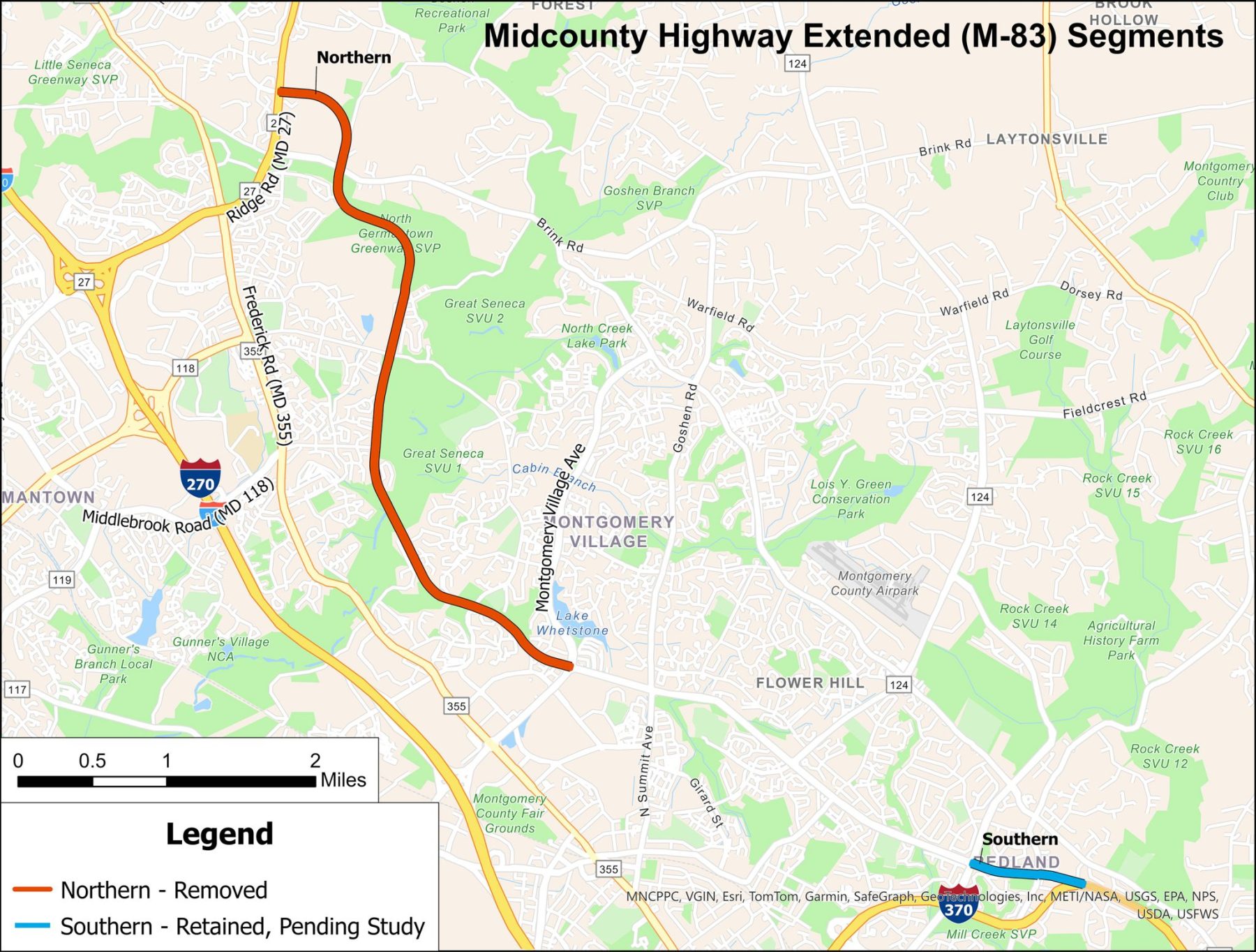The Master Plan of Highways and Transitways (MPOHT) is a functional master plan that provides a “road map” for making transportation investments in the county. It includes provisions that impact all modes of transportation, including preserving rights-of-way to accommodate future transportation systems, identifying street classification, number of planned general purpose lanes and transit lanes, and designating target speeds for individual roadways.
Public Hearing Draft
The Planning Board held public hearings on the Master Plan of Highways and Transitways – 2025 Technical Update on:
- September 12, 2024: View the video and staff report.
- November 14, 2024: View the video and staff report
- January 9, 2025: View the video and staff report
At the conclusion of three public hearings, planning staff summarized all comments received between June 26, 2024 and January 24, 2025. Each comment was reviewed and draft responses were provided by Planning Staff. The focus of the next series of work sessions was to discuss key comments received, share the planning staff rationale for each key comment, and modify as directed by the Planning Board. Work sessions were previously held on three dates with one upcoming date remaining to present the draft Planning Board draft document:
- February 13, 2025: View the video and staff report
- March 6, 2025: View the video and staff report
- March 20, 2025: View the video and staff report
- April 10, 2025: Materials will be provided after April 3
Draft recommendations on Midcounty Highway Extended:
- Remove the northern section of M-83 from the MPOHT as it is inconsistent with Thrive Montgomery 2050 and the county’s Climate Action Plan.
- Conduct a comprehensive study of travel needs along the Clarksburg to Germantown corridor to determine if there is sufficient master-planned transportation capacity to accommodate planned development.
- Retain the southern section of M-83 between Shady Grove Road and the Intercounty Connector (ICC) until a more detailed planning and engineering feasibility study can be completed.

Resolution on status of northern segments of Midcounty Highway Extended
At the conclusion of the Work Session #1 on February 13, the planning board approved the following recommendations:
- Remove the northern section of Midcounty Highway Extended from the MPOHT as it is inconsistent with Thrive Montgomery 2050 and the Climate Action Plan.
- Conduct a comprehensive study of travel needs along the Clarksburg to Germantown corridor to determine if there is sufficient master-planned transportation capacity to accommodate planned development
Resolution on status of southern segments of Midcounty Highway Extended
At Work Session #2, planning staff demonstrated a new web app to show Clarksburg to Germantown Transportation Infrastructure. This map provides information on existing and proposed transportation infrastructure, including the proposed Scenario 1 from the 2017 Midcounty Corridor Study Supplemental Report.
During the first work session the Planning Board requested a better understanding of the status of transportation infrastructure in the Clarksburg to Germantown area. In response, Planning Staff develop a GIS web application that shows the existing and planned highways, transitways, and bikeways in this portion of the county, with one map for each mode. Each map symbolizes features based on its “Status,” summarized as follows:
- Fully Constructed – Post 2019
- Fully Constructed – Pre 2019
- Partially Constructed
- Not Constructed – Funded for Construction
- Not Constructed – Funded for Design
- Not Constructed – Approved Development
- Not Constructed – Master-Planned Only
At the conclusion of Work Session #3 on March 20, 2025, the planning board approved the following recommendation: that the southern section of Midcounty Highway Extended (M-83) between Shady Grove Road and the ICC be retained in the Master Plan of Highways and Transitways until a more detailed planning and engineering feasibility study can be completed. Planning Staff also summarized preliminary concepts for a comprehensive study of travel needs along the Clarksburg to Germantown corridor to determine if there is sufficient master-planned transportation capacity to accommodate planned development.
At Work Session #4 on April 10, 2025. the Planning Board reviewed the final draft of the plan and authorized staff to publish and transmit the revised draft as the Planning Board Draft to the County Executive and the County Council.
Frequently Asked Questions
Target speed is the desired operating speed for a roadway. This is in contrast to the posted speed limit, which is the legally enforceable speed limit and is oftentimes higher than the target speed. The posted speed limit can become the target speed limit when all of the factors that influence travel speed are in place, including adjacent land use, access to adjacent land use, building massing and setbacks, pedestrian and bicycle activity, road classification and function, traffic control, intersection spacing, traffic calming, posted speed limit, enforcement and roadway geometry. On a well-designed street, the target speed is self-enforcing.
Complete Streets are roadways that are designed and operated to provide safe, accessible, and healthy travel for all users of the roadway system, including pedestrians, bicyclists, transit riders, and motorists. On a complete street, it is intuitive and safe to cross the street, walk to shops, and bicycle to school. The approach to Complete Streets will vary in different parts of Montgomery County. Complete Streets in rural Boyds, suburban Olney, and downtown Wheaton will all look different depending on the adjacent land uses. Some areas may have dedicated bus only lanes on certain streets, and some streets may vary in what degree of bicycle facilities they have or whether they require any bike facilities at all. Complete Streets function as a system, ensuring that the transportation network as a whole provides safe and efficient access for all roadway users and only provides designated spaces for each mode when needed.
Transitioning from the previous street classification system to the CSDG street classification system is a three-step process, with the Master Plan of Highways and Transitways Technical Update representing the third and final step in the process:
- Phase 1: Enactment of Bill 24-22 and Bill 34-22
With the enactment of Bill 24-22 on November 7, 2022 and Bill 34-22 on December 27, 2022, the County Council established interim designations of CSDG Area types (e.g. Downtown, Town Center, etc.), as well as interim translations for CSDG street types (Downtown Boulevard, Downtown Street, Town Center Boulevard, etc.) based on the designated CSDG area types and the previous street classifications. Street types not covered in the CSDG, including Freeways and Parkways, have been grandfathered into the revised MPOHT. Status: Complete - Phase 2: Master Plan Area Types in the Pedestrian Master Plan
To address some deficiencies in the Phase 1 area type designations, the Pedestrian Master Plan replaces the interim area type designations in the county code with permanent area type designations throughout the county. Changes to CSDG street types will occur in locations of the county where the area type is modified. Status: Complete - Phase 3: Master Plan Street Types in a Technical Update to the Master Plan of Highways and Transitways
To address the remaining deficiencies in the Phase 1 street type translations, the plan update will reevaluate the transportation function of all streets to fully ensure that each street is accurately classified. Status: Ongoing with this MPOHT technical update
Montgomery County is in the process of transitioning from an auto-oriented transportation system to one that provides safety, transportation choice and accessibility to county and regional destinations for all modes of transportation. As part of this transition, the county is reclassifying all streets from a “functional classification” approach, which described streets based on their use by automobiles, to a “complete streets” approach, which classifies streets based on the type of land use they serve and the transportation function for all modes of transportation. This transition is necessary to ensure that Montgomery County’s streets are aligned with the county’s safety, equity and climate change goals as articulated in Thrive Montgomery 2050, the Climate Action Plan and the Vision Zero Action Plan.
While many projects have been completed and many are underway, it took Montgomery County over 70 years to build out its auto-oriented transportation system and it will take many more years to retrofit our streets to a “complete streets” approach. Complete Street projects are being implemented through multiple approaches, including major retrofit of an entire roadway, incrementally on portions of a roadway, or through small neighborhood initiatives. Both state and county government, as well as private development, are contributing to these projects.
As a technical update, the purpose of this effort is to ensure that new street types adhere to the vision of streets as identified in previously approved master plans. This vision is aligned with the multimodal focus of the CSDG to ensure that not only do streets adequately serve access and through traffic needs, but also that walking, bicycling and other non-motorized vehicular needs are addressed. Furthermore, the Master Plan of Highways and Transitways does not include Neighborhood Streets and Neighborhood Yield Streets that serve predominantly residential areas with low volumes of motor vehicle traffic, and which represent the vast majority of streets in Montgomery County.
The MPOHT technical update will continue to implement the principles of the CSDG by ensuring that all primary streets in the county are accurately classified. Because they incorporate land use context and a multimodal focus on roadways, the complete streets classifications aim to improve economic competitiveness, racial equity and social justice, and environmental health and resilience, create more transportation choices, and increase access to destinations in the county and the region — all important concepts of Thrive Montgomery 2050.
Staff contact
Sofia Aldrich
301-495-4528
Email
Timeline
-
September 2023Planning Board Scope of Work and First Technical Advisory Group meeting
-
March 2024Development of Recommendations
-
June 2024Working Draft of Plan (June 27, 2024)
-
September 12, 2024Public Hearing #1
-
November 14, 2024Public Hearing #2
-
January 9, 2025Public Hearing #3
-
Spring 2025Planning Board Work Sessions – Development of Planning Board Draft
-
Spring/Summer 2025Montgomery County Council Review


